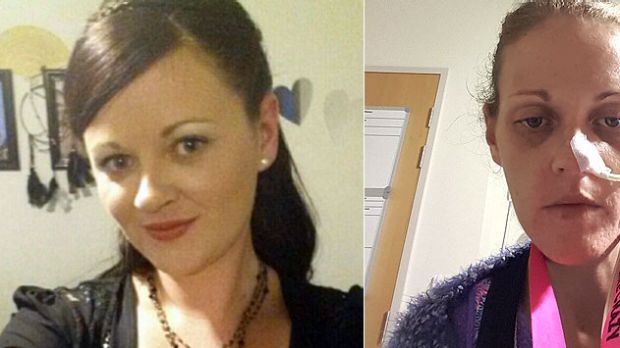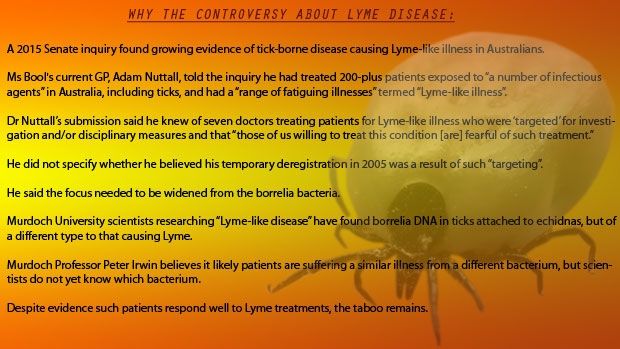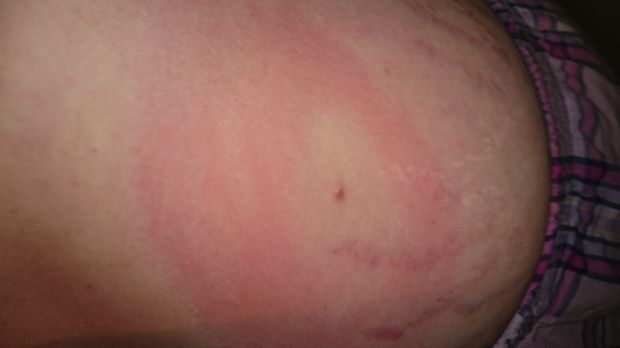A woman who lies, fearing death, in a Perth hospital is the human face of a bitter disagreement in the scientific community over whether Lyme – or "Lyme-like" – disease can occur in Australia.
While the argument over the existence of the tick-borne disease in our country continues, people like Rebecca Bool get sicker - without so much as the comfort of a diagnosis.

Ms Bool, 32, lies in hospital, occasionally picking up pencils and slowly colouring in a mindfulness picture book.
But she cannot eat, drink or walk.
She has great difficulty remembering things, she can't muster the strength to write any more and her eight-year-old son and two daughters, aged 10 and 12, are staying with relatives.
With her sunken features and stick-thin arms, she barely resembles a mother-of-three - a far cry from the woman she was just three years ago.
"That year I was working two days a week, studying three days a week, plus looking after my kids," Ms Bool said of her life back in 2014.
"I had no medical issues, no mental health issues, nothing like that. I was happy, healthy."
But she found a tick on the side of her stomach on Christmas Eve, while holidaying in Kalbarri, and within 24 hours was in hospital.

Ms Bool before she was bitten by a tick, and Ms Bool now.
"It started with my leg getting a bit sore. Then I thought it was gastro…then I lost control of my bladder."
Ms Bool was hospitalised three times during her holiday, then transferred to Geraldton, then Armadale. She was eventually sent home with an "unknown virus".
She said no one looked at her tick-bite or rash.
Fast forward three years and Ms Bool is almost permanently hospitalised with symptoms including seizures that shake her whole body and blind her with pain, sometimes leading to temporary paralysis.
Last year one particularly severe seizure left her unable to swallow and without the use of her right hand.
But referring to her condition as Lyme disease or 'lyme-like' comes with controversy.
Lyme disease is caused by bacteria called borrelia burgdorferi, which is carried by some ticks. When bitten by these ticks, the infection is carried into the bloodstream.
Believed to have originated in Lyme, Connecticut, it can attack multiple organs and mimic other illnesses, making it hard to diagnose.

Ms Bool suffers severe seizures that sometimes result in face paralysis.
At first, a red bullseye rash may appear around the bite, and symptoms may simply be flu-like, with aching muscles, headache, fever and fatigue.
If left untreated, symptoms may include seizures, facial paralysis, twitching of muscles, hair loss, Alzheimers-like symptoms and acute headaches, among others.
The Australian government acknowledges the disease's existence in North America and Europe, but despite increasing talk of a Lyme-like illness in Australia, the WA Health Department says the species of ticks carrying borrelia burgdorferi has not been identified anywhere in Australia.
Perth-based doctor Hugh Derham diagnosed Ms Bool with Lyme disease after sending her blood tests to Australian Biologics, and Infectolab - Germany's premier Lyme disease testing centre.
Ms Bool said both tests came back positive for Lyme disease, even though she had never had a tick bite outside Australia.
"All the co-infections showed up at a lab in Geelong too. They are allowed to treat those co-infections here, but they won't," she said.
"They're not treating me for anything related to Lyme at all."

Lyme disease continues to court controversy in Australia.
Infectious diseases physician and clinical microbiologist Miles Beaman said 30 years of research showed no evidence of Lyme bacteria in patients who had not left the country.
"Those who claim to [have tested positive] used unlicensed laboratories which are not legally endorsed to test patients," he said.
Dr Beaman said Australian Biologics was unlicensed, and Infectolab didn't operate to the standards required in Australia.
He said common medical wisdom was that as Lyme disease could only be obtained outside the country, patients who had not gone overseas should not be tested for Lyme.
Instead, he said they should be tested for rheumatological disease or fatigue syndromes and other infectious agents known to be transmitted by tick bites in Australia.
"In the meantime, symptomatic treatment, including psychological support, should be offered," he said.
But 'symptomatic treatment and psychological support' appear to be failing Ms Bool and others in her position.
Ms Bool has now been listed as a mental health patient and is watched constantly in her hospital room.
"You aren't allowed to go to the toilet by yourself; you've got to have a nurse standing there in the doorway…they don't trust me, it's humiliating," she said.
"I don't feel like I'm in good hands here."

Ms Bool's bull's eye rash around the tick-bite.
Doctors are not the only ones divided on the presence of Lyme disease in Australia - the controversy has torn Ms Bool's family apart.
Last September her husband left her, saying he didn't believe she was sick; but her nasal tube, catheter bag and huge worried eyes show that irrespective of her diagnosis, or lack there of, her journey has been a long and exhausting one.
Three months after the initial tick-bite, feeling abandoned by doctors, Ms Bool tried to take her own life.
In April 2015 she was put into an Armadale mental health facility, and given 12 electric shock treatments.
"The antidepressants weren't working," she said.
"They're not seeing me for the illness I have."
She said once at [another] hospital they left her three days with no nasal feeds, but refused to discharge her. Eventually she self-discharged and went to her current hospital, very ill.
"For about a week or two when I was first here, they took my nasal tube out and they just kept leaving my meds on the bench for me to take," she said.
"They thought if I was faking, I'd take my meds. I can't swallow. I can't eat anything,
"I can't drink anything, and still they don't believe me."

Ms Bool says she often wakes with strange bruises and sores.
While the argument on the presence of Lyme disease in Australia continues, people continue falling sick with Lyme-like symptoms and making allegations of callous treatment by medical professionals.
The disease has now become so taboo that people who acknowledge they were bitten overseas still cannot be diagnosed or treated for it in Australia.
Susan, 72, who preferred her surname not to be published, was bitten by a tick in Nepal in 2005 and diagnosed with Lyme disease by the same German lab as Ms Bool.
Susan was also turned away by Australian doctors, despite having been bitten in areas commonly accepted to contain ticks that carry the borrelia burgorferi bacteria.
She was treated with antibiotics and eventually turned to alternative medicine after seeing no improvement for two years.
"The first doctor I ever went to here in Perth, and mentioned Lyme disease to, told me it was all in my head and referred me to a psychiatrist," she said.
"I spent six months visiting the psychiatrist and he also told me it was all in my head."
Many Australians with Lyme-like symptoms, therefore, end up seeking treatment overseas.
Susan plans to go to Cyprus for treatment in August, but to do so needs to save thousands of dollars.
Another Perth woman, Sharon Badger, has recently completed treatment in Cyprus herself.
Ms Badger had experienced random bouts of illness for 35 years, and was bitten by ticks as a child and in her twenties in WA.
She has travelled overseas, but does not remember being bitten by ticks outside the country.
Ms Badger said blood tests showed she had the co-infections of Lyme disease, and borrelia bacteria were present but again doctors turned her away.
She chose to undertake five weeks of treatment at Hyperbaric Therapy Treatment Centre in Cyprus..
Systematic whole body hyperthermia treatment involves overheating the body to temperatures of over 42 degrees to kill borrelia bacteria that caused Lyme disease.
Hyperbaric oxygen therapy involves patients spending regular 30-minute periods in an oxygen chamber regulated to the equivalence of diving 14 metres. They breathe 100 per cent oxygen, which is said to accelerate healing processes and is effective with many degenerative diseases.
She was one of four Australians seeking the treatment at the centre at the time.
She said before treatment she was unable to walk even a kilometre and spent most of her day sleeping, but within one week of her treatment finishing, claims she was able to walk nine kilometres.
As the debate between clinicians rages on about its existence, a 2015 Senate inquiry found growing evidence of tick-borne disease that causes Lyme-like illness for many Australian patients - informed by submissions including one from Ms Bool's current GP.
That GP said he knew of several doctors ridiculed and targeted for investigation for their willingness to treat people for a spectrum of "Lyme-like" illnesses.
The inquiry included a recommendation that the Australian government increase funding for research into tick-borne pathogens as a matter of urgency.
It also recommended a clinical trial of treatment guidelines be established, with the aim of determining safe treatment protocol for patients with tick-borne disease.
As research into the strange Lyme-like disease continues, scientists at Murdoch University said borrelia DNA had been discovered in ticks attached to echidnas, but their analysis revealed it was a new type of borrelia that was not part of the group that causes Lyme disease.
Professor Peter Irwin of the university's Vector and Waterborne Pathogen Research Group said it was likely they were suffering a similar illness, from a different bacterium.
"The problem is we don't know what bacteria yet," he said.
Despite evidence that such patients respond well to Lyme treatments, the taboo remains.
President of the Lyme Disease Association of Australia Sharon Whiteman said no one had taken leadership.
"The government focuses on 25-year-old research on ticks, and no research has been done on current patients," she said.
"There were 1200 submissions to the senate inquiry, and the majority were patients.
"Doctors have changed to evidence based medicine – that doesn't work with an emerging disease because there is no evidence. The patient is the evidence."
The Association claims there are 22,000 new cases of Lyme disease in Australia each year.
A spokesperson for Federal Health Minister Greg Hunt said while medical authorities had yet to conclude that Lyme disease existed in Australia, he believed families deserved a full medical review and analysis.
But this may come too late for Rebecca Bool.
Sitting in the sun in her wheelchair, watching traffic go by, Ms Bool said she wanted to ask the government and the Australian medical system to properly look into Lyme-like illness.
"Stop mocking us, stop putting us down. How are you going to explain to our families why we're not here anymore?" she said.
"My daughter the other day asked me what I wanted for her when she was older.
"It's the first time she's mentioned that I might not be here to see it."
0 comments
New User? Sign up